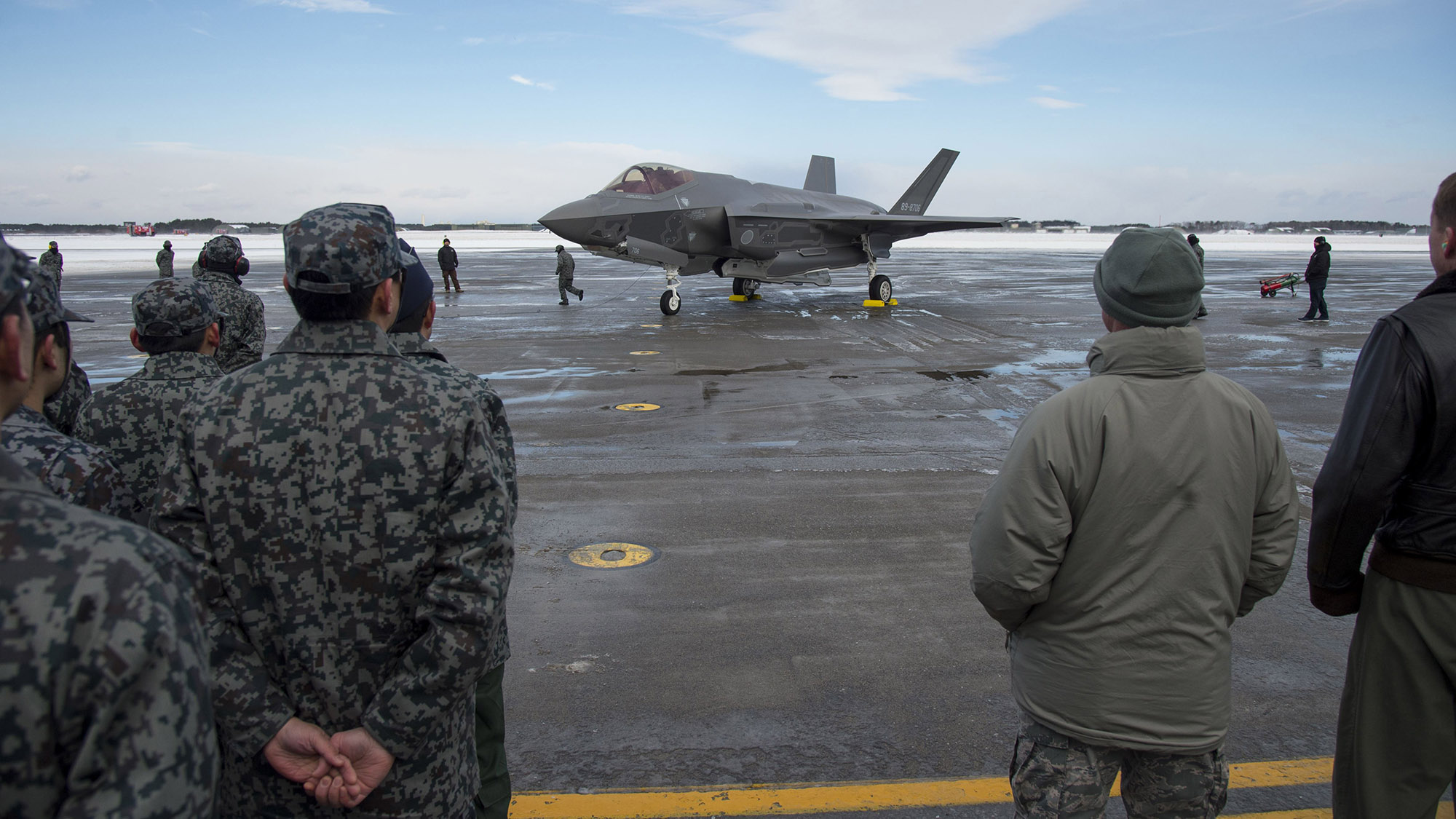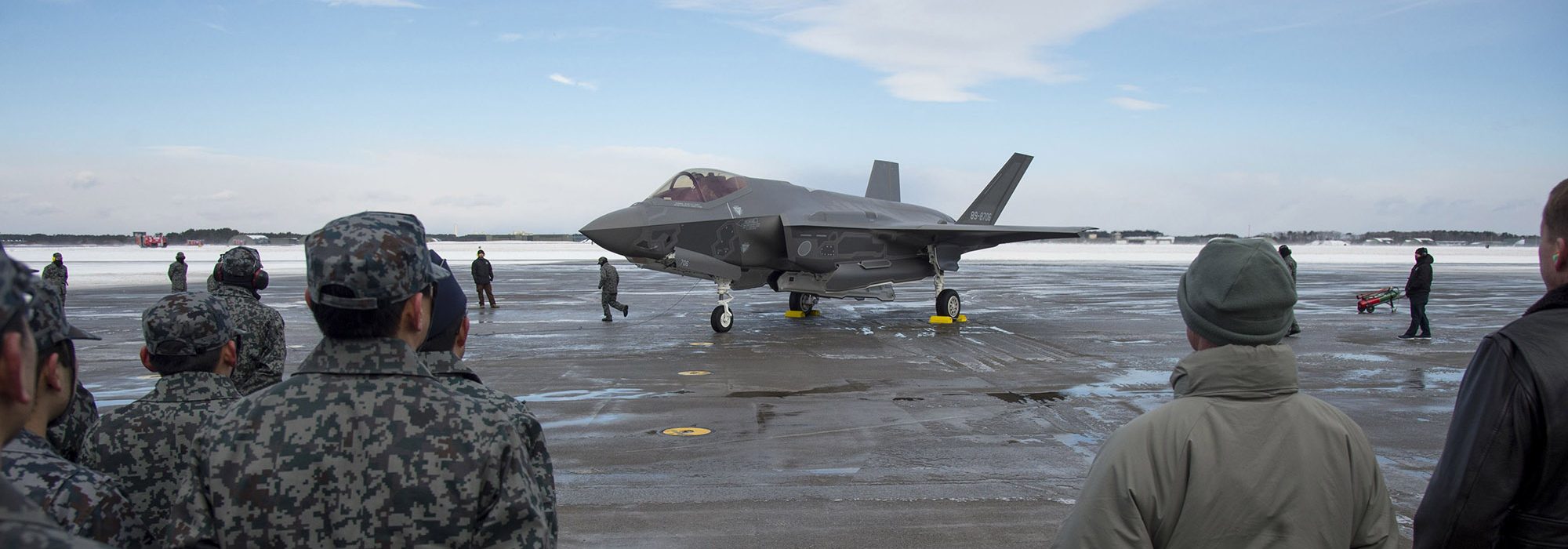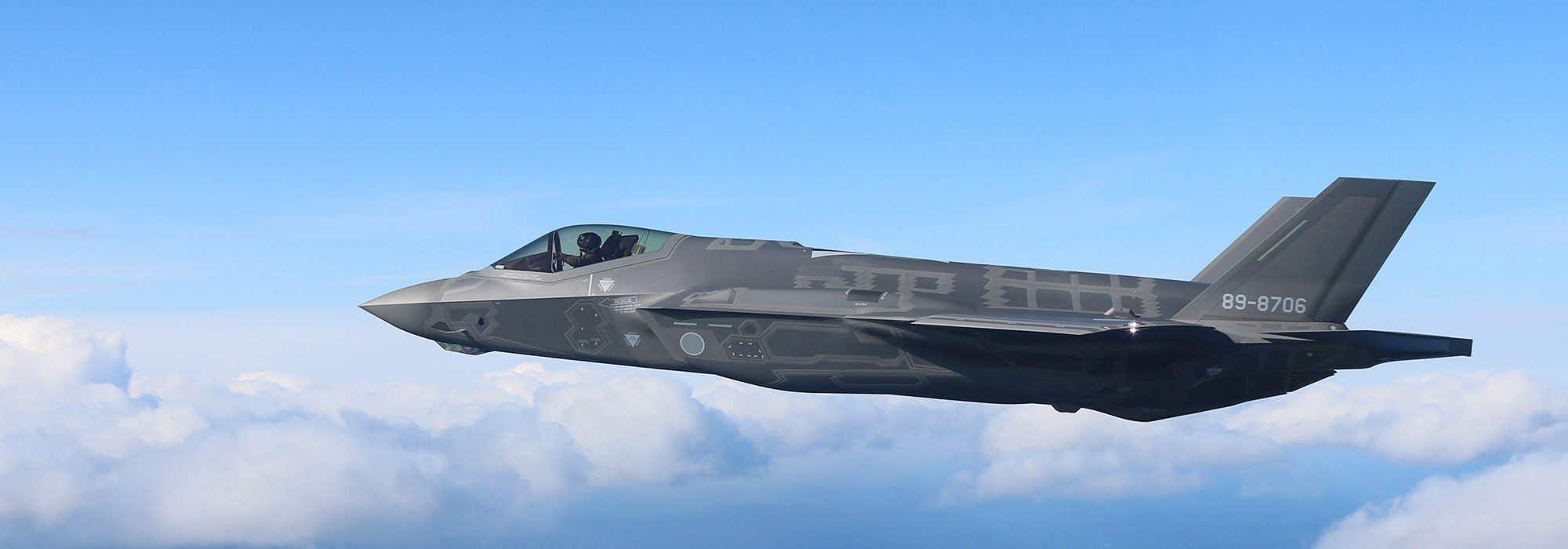USAF and the Japan Air Self-Defense Force are taking bilateral interoperability to the next level with joint F-35 training.
MISAWA AIR BASE, Japan—
Pacific Air Forces doesn’t have many F-35s. Yet.
However, within five years, there will be more than 200 Joint Strike Fighters in the region—70 percent of them owned and operated not by the U.S. Air Force, but by its allies. Japan is acquiring 147 F-35s—105 A models and 42 B models—making it the single biggest international customer for the fifth-generation jets.
Ensuring all those aircraft are truly interoperable is a critical challenge, and there’s no time like the present to get that ball rolling, said Chief Master Sgt. Brian Kruzelnick, command chief master sergeant for 5th Air Force.
“We’re always looking for ways for the U.S. Air Force and the Japan Air Self-Defense Force to become more interoperable,” Kruzelnick said. Japan released its annual Defense of Japan white paper, which outlines its defense policy, strategy, and priorities. “They really highlighted the fact that the U.S. and Japan alliance is the cornerstone for any multilayered, multifaceted security cooperation between allied partners in the region.”
So when the Japan Air Self-Defense Force (JASDF) approached 5th Air Force about an F-35 maintenance exchange, it seemed like the “perfect opportunity to come in on the ground level and grow our interoperability together,” he said. Except that 5th Air Force doesn’t have any F-35s of its own.
The overarching reason we’re here is to support the [Air Force] Chief of Staff’s vision of strengthening our alliances.Col. Michael Miles, commander of the 388th Maintenance Group
Enter the 388th Fighter Wing from Hill Air Force Base, Utah—the only USAF combat unit with F-35s.
“The overarching reason we’re here is to support the [Air Force] Chief of Staff’s vision of strengthening our alliances,” said Col. Michael Miles, commander of the 388th Maintenance Group, speaking louder as Japanese F-35s roared overhead. “This endeavor fits right into that priority. And the joint strike fighter, F-35, really enables a different level of cooperation than any other platform we have.”
All F-35 units share training, technical data, tools, and a common program support infrastructure, he said. But by “cooperating and sharing lessons learned, we can actually raise everybody’s performance within the program.”
Miles and seven of his Airmen flew to Misawa Air Base, Japan, in December for a two-day F-35 maintenance symposium, featuring briefings and lessons-learned discussions as well as hands-on training on specific maintenance tasks.
“My Airmen, the U.S. Air Force Airmen that I brought with me, always take back lessons learned from who we’re talking to within the program, so the value to us back at Hill Air Force Base is a greater understanding of the F-35 from the Japanese perspective that we’ll see and hear about,” he said.
The group from Hill included low observable and analysis specialists, as well as a crew chief and a maintenance officer, and their hosts were grateful to tap their expertise.
“The 388th Maintenance Group has great experience and great knowledge,” said a JASDF ammunition maintainer who declined to give his name. “We learned many things,” he said, adding that he was looking forward to hands-on training on weapons loading. “This maintenance day will contribute to our interoperability.”
Hill Airmen have previously hosted JASDF maintenance delegations in the U.S., and in 2018 the maintenance group sent a training team here for weapons loading and aircraft gun training. The continued collaboration has helped establish a “recurring battle rhythm of mutual support,” Miles said.
“The idea would be to continue this engagement as we both learn more about the F-35 and the way they capitalize on its capabilities,” he said.
The airplane was designed to be interoperable between users, “whether you’re a pilot flying it or a ground maintainer handling it,” Miles explained. “So we’re trying to break through policy and force the program to design some common ways that we can be interoperable on the ground” as well. “There are multiple levels to that beyond just flying.”
Lt. Gen. Kevin Schneider, commander of U.S. Forces Japan and 5th Air Force, said joint training such as this “supports our strategic objectives to seamlessly integrate during conflict and rapidly reconstitute aircraft, providing overwhelming air power against any adversary.”
Eventually, he said, “I envision Koku Jieitai airmen … generating U.S. Air Force F-35 sorties and vice versa. A projection of our integrated capabilities can deter threats; but, if deterrence fails, we must be ready to win in conflict.”
Kruzelnick envisions building a “fifth-generation fighter ecosystem” throughout the region, “where potentially at some point, any aircraft can land in the Pacific, regardless of tail flash, and any maintainer, regardless of nationality, can come out and generate that aircraft.”
As Kruzelnick put it, the objective is “really to build toward our ability to increase deterrence and then win if deterrence happens to fail.”


Front Line
Misawa is at the front line of deterrence: China, North Korea, and Russia are all within an hour’s flight of the base, and JASDF jets based here are on alert whenever there’s an incursion into Japanese air space.
JASDF fighters scrambled to intercept foreign military aircraft 246 times in the three months from April through June 2019, or nearly three times per day. Three-quarters of those incursions were by Chinese airplanes, with Russia accounting for the vast majority of the rest, according to the Japanese Ministry of Defense.
The frequency of foreign military aircraft nearing or entering Japanese air space is on the rise, according to the U.S. military newspaper Stars and Stripes. It said intercepts of Chinese aircraft rose 27.6 percent from fiscal 2017 to fiscal 2018.
Former Japanese Minister of Defense Takeshi Iwaya, in the annual Defense of Japan report, said the security environment around Japan “is becoming more testing and uncertain at a remarkably faster speed than we expected.”
He added: “China is expanding and stepping up its activities in the seas and airspace neighboring Japan, with more and more fighters and bombers advancing to the Sea of Japan and the Pacific Ocean.”
A Russian military airplane taking part in joint patrols with China entered Japanese airspace in late July in an action Japanese officials viewed as a test of Japan’s relationships with the U.S. and South Korea, according to The Japan Times.
At the time, Pacific Air Forces Commander Gen. Charles Q. Brown Jr. called it “a potential harbinger of things that could happen in the future.”
JASDF leaders also reached out to the 35th Fighter Wing’s munitions section last year for training in building GBU-12s and loading them onto Japanese F-35s.
Building GBU-12s is “something we do all the time, every single exercise,” explained Senior Master Sgt. Edgar Ulrich, the 35th Maintenance Squadron’s munitions production section chief.
The American munitions Airmen put together a team, led by Staff Sgt. Kyle Horvat, the conventional maintenance production supervisor, to train their Japanese counterparts on how to build them safely.
Horvat said the team trained 20 Japanese airmen to build GBU-12s, then helped them test the weapons over a four-day training event. Prior to that, the munitions section provided four different bomb variants, he said, “so they could practice loading different munitions onto the F-35, since it’s a new platform for them.”
The munitions Airmen expect to train JASDF weapons crews on GBU-31s and small diameter bombs in the next few months, said Chief Master Sgt. Plez Glenn, the munitions flight chief.
Each of these activities contributes to the larger goal of bilateral cooperation and interoperability—a concept this base takes seriously.
“We’re the only truly bilateral flying operation here in Japan,” so there is plenty of day-to-day interaction between U.S. Airmen and JASDF members, explained Col. Kristopher Struve, commander of the 35th Fighter Wing.
Social functions and festivals also help “close the gap between our cultures,” he said. There are “some great opportunities back and forth for U.S. to just bridge the seams and really work on that interoperability piece, which is going to be critical if we have to go to war together.”
These engagements are at all levels, he noted, from the “logistical to tactical level.”
“We may need to be able to shoot and scoot, but we also need to be able to operate together, be it maybe in a shared strike or in shared air defense,” Struve said. “Maybe they’re manning a [combat air patrol], or manning a CAP next to us, or we’re working together, and CAP is swapping out with them. Us working together to increase interoperability, increase our tactical proficiency together, and learn from each other is really invaluable, and since we are here on the yard together, we can do that on a routine basis.”
Misawa is “a unique location to provide deterrence and help maintain the free and open Pacific,” he said. “We’re prepared all the time, ready for any aggression from North Korea, Russia, [or] China.”
Wide Expanse
The Pacific is a very big place, Miles said, and because of the “time-space problems” in the theater, “you’ve got to have—in my mind—the capability to have airplanes dispersed throughout the theater and supported by our allies. And that’s [what] we’re getting at, with common tech data for launch and recovery, and then, eventually, grow to where we can repair each other’s airplanes, load each other’s airplanes with ammunition and weapons. We’re really on the first stage of that … so we need to continue to push toward that goal. ‘How do we get the most out of our alliances, and how do we get the most out of this weapons system in a short time span?’ … We got delivered what we asked for as a DOD and program office. Now,’how do we get the most out of it?’ That’s on us.”

Photo: R. Nial Bradshaw/USAF
Lightning Tech Training
USAF is working to get the most out of its F-35 maintainers through its Lightning Technician Programs. Luke and Hill Air Force bases in Arizona and Utah have “partnered to explore the capabilities of U.S. Air Force Airmen to do multiple things for the F-35,” and the maintainers shared those experiences during the symposium through a comprehensive brief, Col. Michael Miles said.
LTP “is by no means a final product, and it’s not necessarily the way the Air Force is going, but we’re trying to explore the possibilities. What is the art of the possible with F-35 maintenance, given the design of the airplane? The way the prognostic health management system works on the aircraft really opens the door for a new way of doing sustainment, and that’s really what we’re trying to get to and share with other users,” he added.
The program is one way they are looking to build the “next-generation Airman.” Miles said he envisions a next-generation Airman to be multifaceted and able to “use the technology the world offers right now. … There’s so many great electronic devices to enable aircraft maintenance that are not in use. So I think coupling the Airmen we have in the Air Force … giving them the technology to really get the most out of what they can do on the F-35 … the technology that they can use to make them better maintainers.”
He offered an analogy: “We’ve outfitted the pilot of the F-35 with an amazing helmet with everything on the glass. Where is that for the maintainer? Where’s my Google glasses, where I can see the tech data in my glasses while I’m doing a job? … That’s where an F-35 maintainer is really making the Air Force a profit from a human-capital standpoint.”
